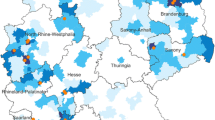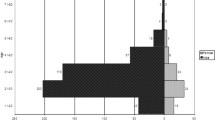Abstract
The aim of the present study was to determine prospectively the antimicrobial susceptibility of Neisseria gonorrhoeae strains collected in southern Germany (Heidelberg and Stuttgart areas). Sixty-five N. gonorrhoeae strains, isolated between July 2004 and June 2005 from patients with uncomplicated gonorrhoea, were tested. Minimum inhibitory concentrations of penicillin, tetracycline, ciprofloxacin, azithromycin, spectinomycin, ceftriaxone, and cefixime were determined by the E test. All isolates were fully susceptible to ceftriaxone, cefixime, and spectinomycin. However, 21.5% (14/65), 29.2% (19/65), and 47.7% (31/65) of isolates were resistant to penicillin (>2.0 mg/l), tetracycline (>2.0 mg/l), and ciprofloxacin (>1.0 mg/l), respectively. Critical MICs of azithromycin (>1.0 mg/l, as defined by the Neisseria Reference Laboratory at the Centers for Disease Control) were found for five (7.7%) N. gonorrhoeae isolates. These data indicate a high prevalence of N. gonorrhoeae strains resistant to the antimicrobial agents currently used to treat gonococcal infections in the Heidelberg and Stuttgart areas. Even though the findings may not be representative of the general population in Germany, they nevertheless illustrate the need to establish an antimicrobial resistance surveillance system in order to control gonorrhoea effectively.
Similar content being viewed by others
References
Fenton KA, Lowndes CM, and the European Surveillance of Sexually Transmitted Infections (ESSTI) Network (2004) Recent trends in the epidemiology of sexually transmitted infections in the European Union. Sex Transm Infect 80:255–263
Bremer V, Marcus U, Hofmann A, Hamouda O (2005) Building a sentinel surveillance system for sexually transmitted infections in Germany, 2003. Sex Transm Infect 81:173–179
National Committee for Clinical Laboratory Standards (2004) Performance standards for antimicrobial susceptibility testing: twelfth informational supplement: M100-S14. Wayne, Pennsylvania, USA
Centers for Disease Control and Prevention (2003) Neisseria gonorrhoeae reference strains for antimicrobial susceptibility testing. http://www.cdc.gov/std/gisp/B88text6132003.pdf. Cited 2 August 2005
Schäfer V, Enzensberger R, Schneider C, Rickmann J, Nitschke-Özbay H, Brade V (1995) Epidemiology of penicillin-resistant Neisseria gonorrhoeae in Frankfurt, Germany. Eur J Clin Microbiol Infect Dis 14:914–918
Wagner J, Tebbe B, Hörnle R, Chahin M, Arvand M, Wendt C, Orfanos CE, Hahn H (2000) Antibiotikaempfindlichkeit von Neisseria-gonorrhoeae-Isolaten in Berlin. Hautarzt 51:666–669
Vogel F, Scholz H, Al-Nawas B, Elies W, Kresken M, Lode H, Müller O, Naber KG, Petersen E, Shah P, Sörgel F, Stille W, Tauchnitz C, Trautmann M, Ullmann U, Wacha H, Wiedemann B (2002) Rationaler Einsatz oraler Antibiotika bei Erwachsenen. Chemotherapie J 11:47–58
Lassus A (1990) Comparative studies of azithromycin in skin and soft-tissue infections and sexually transmitted infections by Neisseria and Chlamydia species. J Antimicrob Chemother 25(Suppl A):115–121
Habib AR, Fernando R (2004) Efficacy of azithromycin 1 g single dose in the management of uncomplicated gonorrhoea. Int J STD AIDS 15:240–242
Martin DH, Mroczkowski TF, Dalu ZA, McCarty J, Jones RB, Hopkins SJ, Johnson RB (1992) A controlled trial of a single dose of azithromycin for the treatment of chlamydial urethritis and cervicitis. The Azithromycin for Chlamydial Infections Study Group. N Engl J Med 327:921–925
Waugh MA (1993) Open study of the safety and efficacy of a single oral dose of azithromycin for the treatment of uncomplicated gonorrhoea in men and women. J Antimicrob Chemother 31(Suppl E):193–198
Young H, Moyes A, McMillan A (1997) Azithromycin and erythromycin resistant Neisseria gonorrhoeae following treatment with azithromycin. Int J STD AIDS 8:299–302
Tapsall JW, Shultz TR, Limnios EA, Donovan B, Mulhall BP (1998) Failure of azithromycin therapy in gonorrhea and discorrelation with laboratory test parameters. Sex Transm Dis 25:505–508
Handsfield HH, Dalu ZA, Martin DH, Douglas JM Jr, McCarty JM, Schlossberg D (1994) Multicenter trial of single-dose azithromycin vs. ceftriaxone in the treatment of uncomplicated gonorrhoea. Azithromycin Gonorrhoea Study Group. Sex Transm Dis 21:107–111
Kent CK, Chaw JK, Wong W, Liska S, Gibson S, Hubbard G, Klausner J (2005) Prevalence of rectal, urethral, and pharyngeal chlamydia and gonorrhea detected in 2 clinical settings among men who have sex with men: San Francisco, California, 2003. Clin Infect Dis 41:67–74
McCormack WM, Finland M (1976) Drugs five years later. Spectinomycin. Ann Intern Med 84:712–716
World Health Organization (1997) Management of sexually transmitted diseases. WHO, Geneva. http://whqlibdoc.who.int/hq/1997/WHO_GPA_TEM_94.1_Rev.1.pdf. Cited 9 November 2005
Cohen MS, Pilcher CD (2005) Amplified HIV transmission and new approaches to HIV prevention. J Infect Dis 191:1391–1393
Tapsall JW (2005) Antibiotic resistance in Neisseria gonorrhoeae. Clin Infect Dis 41(Suppl 4):S263–S268
Acknowledgements
We gratefully acknowledge the excellent cooperation of all the clinicians who provided information for this analysis. We also thank Mrs. Simone Jungaberle and Mrs. Hajer Zoghlami for excellent technical assistance.
Author information
Authors and Affiliations
Corresponding author
Additional information
An erratum to this article can be found at http://dx.doi.org/10.1007/s10096-006-0158-3
Rights and permissions
About this article
Cite this article
Enders, M., Turnwald-Maschler, A. & Regnath, T. Antimicrobial resistance of Neisseria gonorrhoeae isolates from the Stuttgart and Heidelberg areas of southern Germany. Eur J Clin Microbiol Infect Dis 25, 318–322 (2006). https://doi.org/10.1007/s10096-006-0134-y
Published:
Issue Date:
DOI: https://doi.org/10.1007/s10096-006-0134-y




